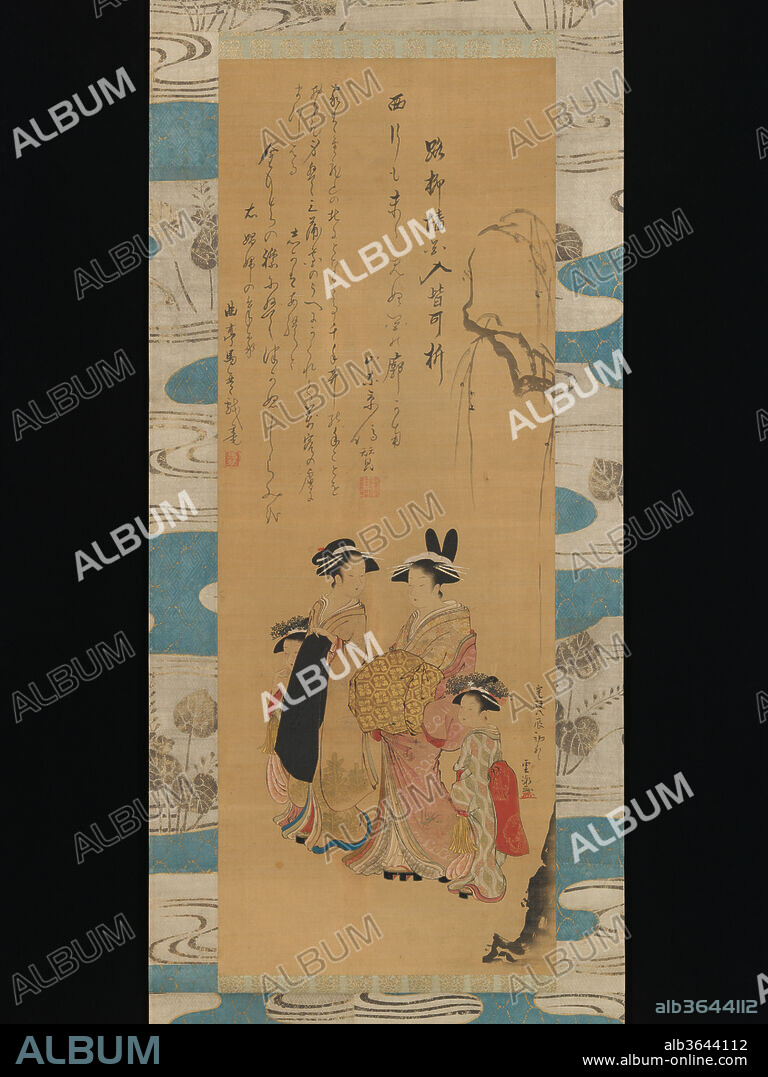alb3644112
UNCHO, INSCRIBED BY KITAO MASANOBU (SANTO KYODEN), INSCRIBED BY KYOKUTEI BAKIN. Courtesan and her Attendants under a Willow Tree

|
Add to another lightbox |
|
Add to another lightbox |



Author:
Title:
Courtesan and her Attendants under a Willow Tree
Caption:
Courtesan and her Attendants under a Willow Tree. Artist: Uncho (Japanese, active late 18th century); Inscribed by Kitao Masanobu (Santo Kyoden) (Japanese, 1761-1816); Inscribed by Kyokutei Bakin (1767-1848). Culture: Japan. Dimensions: 36 1/2 x 13 3/8 in. (92.7 x 34 cm)
Overall with mounting: 72 13/16 × 18 7/8 in. (185 × 48 cm)
Overall with knobs: 72 13/16 × 20 5/8 in. (185 × 52.4 cm). Date: 1796.
A high-ranking courtesan (oiran), accompanied by her teenage apprentice (shinzo) and two child attendants (kamuro), promenade beneath a weeping willow in the spring. While the identity of the artist who signs himself "Uncho" has yet to be determined, we may assume that he received his art name from the ukiyo-e artist Katsukawa Shuncho.
The two inscribers of the poetry above, Kyoden and Bakin, are among the greatest popular writers of the day. They have both added Chinese and Japanese poetic phrases referring to the Yoshiwara pleasure quarters. Kyoden uses metaphors of willow trees and flowers; Bakin quotes a Chinese poem and then likens a courtesan to a thousand-armed Kannon bodhisattava in the service of men.
Technique/material:
Hanging scroll; ink, color, and gold on silk
Period:
Edo period (1615-1868)
Museum:
Metropolitan Museum of Art, New York, USA
Credit:
Album / Metropolitan Museum of Art, NY
Releases:
Model: No - Property: No
Rights questions?
Rights questions?
Image size:
3148 x 4200 px | 37.8 MB
Print size:
26.7 x 35.6 cm | 10.5 x 14.0 in (300 dpi)
Keywords:
ASIA • ASIAN ART • EDO PERIOD (1615-1868) • GOLD • HANGING SCROLL; INK, COLOR, AND GOLD ON SILK • HANGING SCROLLS • INK • INSCRIBED BY KITAO MASANOBU (SANTO KYODEN) • INSCRIBED BY KYOKUTEI BAKIN • JAPAN • METAL • METROPOLITAN MUSEUM OF ART, NEW YORK, USA • PAINTINGS • SCROLL PAINTINGS • SCROLLS • SILK • TEXTILES: SILK • UNCHO
 Pinterest
Pinterest Twitter
Twitter Facebook
Facebook Copy link
Copy link Email
Email
